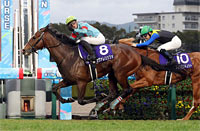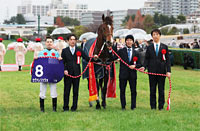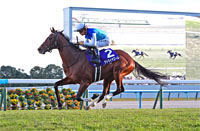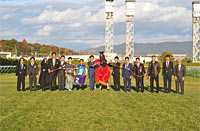Asahi Hai Futurity Stakes (G1) - Data Analysis
Champion race that brings together outstanding 2-year-olds
The Asahi Hai Futurity Stakes is a champion race for 2-year-olds that was established in 1949. It was moved to Hanshin Racecourse from 2014. Many runners that have entered the race—not only its winners but also those that have been defeated in the race—have performed well in subsequent G1 races. This makes the Asahi Hai Futurity Stakes a must-watch G1 race. Let’s now analyze some trends in results based on data mainly for the seven years since 2014, when the race was moved to the 1,600m turf course of Hanshin Racecourse.
Horses born early in the year have enjoyed success
It is often said that “horses born early in the year have an advantage in races for 2-year-olds,” and the data for the Asahi Hai Futurity Stakes over the last seven years bears this out. Since 2014, runners that were born between January and March have secured six victories, while runners that were born in April or beyond have only notched one win. The data also show a major divergence between these two groups in terms of Top 2 ratios and Top 3 ratios. We should therefore first of all confirm the month of birth of this year’s runners. [Table 1]
[Table 1] Performance by month of birth (last seven years)
| Month of birth |
Performance
[1st-2nd-3rd-4th or lower] |
Win ratio |
Top 2 ratio |
Top 3 ratio |
| January-March |
6-7-5-54 |
8.3% |
18.1% |
25.0% |
| April or later |
1-0-2-40 |
2.3% |
2.3% |
7.0% |
Clear gap between runners with 4 career starts and those with 5 career starts
Over the last seven years, runners with 5 or more career starts have produced zero Top 3 finishers. Even if we go back 10 years, the only runners with 5 or more career starts to finish in the Top 3 were 2012 winner Logotype and 2011 third-place finisher Leo Active. In the Asahi Hai Futurity Stakes races held in recent years, there appears to have been a clear gap between runners with 4 career starts and those with 5 career starts. This suggests that, when planning bet formations, we should focus on runners with 4 or fewer career starts, and lower our expectations of those with 5 or more career starts. [Table 2]
[Table 2] Performance by total career starts (last seven years)
| Total career starts |
Performance
[1st-2nd-3rd-4th or lower] |
Win ratio |
Top 2 ratio |
Top 3 ratio |
| 4 or fewer |
7-7-7-73 |
7.4% |
14.9% |
22.3% |
| 5 or more |
0-0-0-21 |
0% |
0% |
0% |
Runners with 2 or more wins have performed well, but runners with 1 win have supported high payouts
Although the Asahi Hai Futurity Stakes is a G1 race that is accessible to many runners with 1 win (provided, however, that they are selected), the runners that tend to fare well in this race are unsurprisingly those with 2 or more wins. Going strictly by success ratios, our focus should be on runners with 2 or more wins, but runners with 1 win have contributed to high payouts in the past. Such examples have included 2020 winner Grenadier Guards (backed as 7th favorite) and 2019 third-place finisher Gran Rey (backed as 14th favorite). Incidentally, the five runners with 1 win that finished in the Top 3 had all secured their single victory in a race with a distance other than 1,600m. [Table 3]
[Table 3] Performance by number of wins in JRA races (last seven years)
| Number of wins |
Performance
[1st-2nd-3rd-4th or lower] |
Win ratio |
Top 2 ratio |
Top 3 ratio |
| 2 or more |
5-6-5-51 |
7.5% |
16.4% |
23.9% |
| 1 or 0 |
2-1-2-43 |
4.2% |
6.3% |
10.4% |
Runners that had previously won a graded race have finished in the Top 3 each year
Among runners that entered the race over the last seven years, those that had previously won a graded race finished in the Top 3 each year, delivering excellent performance of [3-4-4-20] (Top 3 ratio of 35.5%). Even though this is a G1 race for 2-year-olds, which have short careers, runners that have previously secured a victory in a graded race have the edge. [Table 4]
[Table 4] Runners with a previous win in a graded race that finished in the Top 3 (last seven years)
| Year |
Finish |
Winner |
Previous graded race that was won |
| 2014 |
3rd |
Clarity Sky |
Icho Stakes |
| 2015 |
2nd |
Air Spinel |
Daily Hai Nisai Stakes |
| 2016 |
2nd |
Monde Can Know |
Keio Hai Nisai Stakes |
| 2017 |
1st |
Danon Premium |
Saudi Arabia Royal Cup |
| 3rd |
Tower of London |
Keio Hai Nisai Stakes |
| 2018 |
1st |
Admire Mars |
Daily Hai Nisai Stakes |
| 3rd |
Gran Alegria |
Saudi Arabia Royal Cup |
| 2019 |
1st |
Salios |
Saudi Arabia Royal Cup |
| 2nd |
Taisei Vision |
Keio Hai Nisai Stakes |
| 2020 |
2nd |
Stella Veloce |
Saudi Arabia Royal Cup |
| 3rd |
Red Belle Aube |
Daily Hai Nisai Stakes |
Strong showing by Deep impact’s colts
Deep impact’s colts have historically performed well on the 1,600m turf course at Hanshin Racecourse, winning 13 of the total 64 such races held in 2020 (Win ratio of 13.4%, Top 2 ratio of 23.7%, and Top 3 ratio of 38.1%). This trend has applied to the Asahi Hai Futurity Stakes as well, with five of the nine runners in this group that entered the race in the last seven years finishing in the Top 3. Incidentally, the Top 3 ratio for the four colts of Deep Impact that were backed as 1st favorite in the race was 100%. Conversely, while the number of colts of Daiwa Major that entered the race was the same as the number of colts of Deep Impact (namely, nine), the former group considerably lagged the latter group in terms of success ratios. [Table 5]
[Table 5] Performance by major sires (last seven years)
| Sires |
Performance
[1st-2nd-3rd-4th or lower] |
Win ratio |
Top 2 ratio |
Top 3 ratio |
| Deep Impact |
3-0-2-4 |
33.3% |
33.3% |
55.6% |
| King Kamehameha |
1-1-0-3 |
20.0% |
40.0% |
40.0% |
| Daiwa Major |
1-0-1-7 |
11.1% |
11.1% |
22.2% |
| Frankel |
1-0-0-1 |
50.0% |
50.0% |
50.0% |
| Heart’s Cry |
1-0-0-1 |
50.0% |
50.0% |
50.0% |
| Lord Kanaloa |
0-1-0-4 |
0% |
20.0% |
20.0% |
| Kinshasa no Kiseki |
0-1-0-5 |
0% |
16.7% |
16.7% |
| Screen Hero |
0-1-0-5 |
0% |
16.7% |
16.7% |
Note: The horses above sired either five or more colts that entered the race, or a winner of the race.
Runners starting in the inner brackets have a slight advantage
Runners starting in the inner brackets of the 1,600m turf course of Hanshin Racecourse tend to perform well. In particular, those starting in Bracket 1 have enjoyed success, achieving a Win ratio of 12.2% and a Top 3 ratio of 27.3% in the three years from 2018 to 2020. In the Asahi Hai Futurity Stakes over the last seven years, runners starting in Bracket 1 have produced three winners: Danon Platina in 2014, Danon Premium in 2017, and Grenadier Guards in 2020. [Table 6]
[Table 6] Performance by bracket number in 1,600m turf races held at Hanshin Racecourse (2018-2020)
| Bracket number |
Performance
[1st-2nd-3rd-4th or lower] |
Win ratio |
Top 2 ratio |
Top 3 ratio |
| 1 |
29-17-19-173 |
12.2% |
19.3% |
27.3% |
| 2 |
13-19-22-192 |
5.3% |
13.0% |
22.0% |
| 3 |
27-19-19-194 |
10.4% |
17.8% |
25.1% |
| 4 |
16-21-16-217 |
5.9% |
13.7% |
19.6% |
| 5 |
23-19-22-227 |
7.9% |
14.4% |
22.0% |
| 6 |
17-28-24-236 |
5.6% |
14.8% |
22.6% |
| 7 |
27-23-21-285 |
7.6% |
14.0% |
19.9% |
| 8 |
21-25-29-305 |
5.5% |
12.1% |
19.7% |
Seek out the winner!
Focus on runners coming straight from a victory in a race held since October
The last seven winners had all triumphed in their previous race. Consequently, there appears to be little incentive to target runners that were defeated last time out. In addition, all seven winners had won a race held since October, and winners that had contested an allowance race in their previous outing had all won a race held since November, and rode that momentum to secure a victory in the Asahi Hai Futurity Stakes. When predicting win contenders, we should therefore consider the timing and finish of the previous race, along with the data described above. [Table 7]
[Table 7] Winners’ previous race and finish (last seven years)
| Year |
Winner |
Previous race |
Finish in previous race |
| 2014 |
Danon Platina |
Nov 30, Begonia Sho |
1st |
| 2015 |
Leontes |
Nov 22, 2yo Newcomer |
1st |
| 2016 |
Satono Ares |
Nov 27, Begonia Sho |
1st |
| 2017 |
Danon Premium |
Oct 7, Saudi Arabia Royal Cup |
1st |
| 2018 |
Admire Mars |
Nov 10, Daily Hai Nisai Stakes |
1st |
| 2019 |
Salios |
Oct 5, Saudi Arabia Royal Cup |
1st |
| 2020 |
Grenadier Guards |
Nov 7, 2yo Maiden |
1st |
(Yodohito Himezono)
|

- Preview
- Barrier draw
- Past performances of runners

- News
- Race result
- Video
- 2025 English

- 2024 English

- 2023 English

- 2022 English

- 2021 English

- 2020 English

- 2019 English

- 2018 English

- 2017 English

- 2016 English

- 2015 English

- 2014 English

- 2013 English

- 2012 English

- Photo Gallery
2025 Winner: Cavallerizzo


2024 Winner: Admire Zoom


|


















